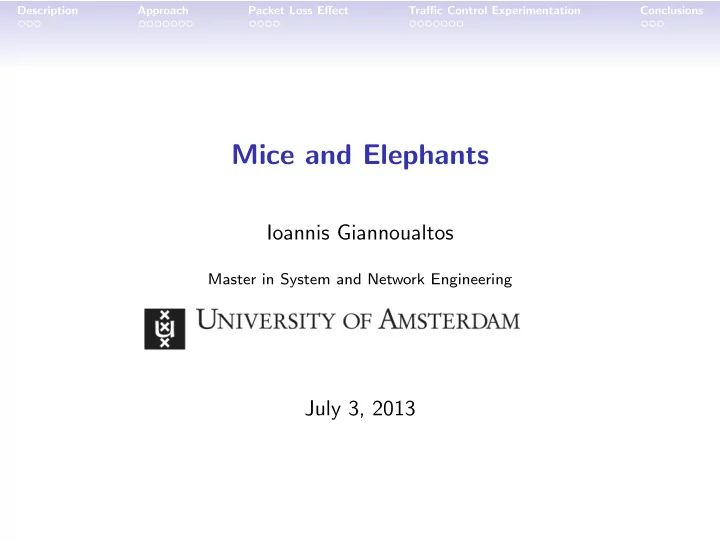

Description Approach Packet Loss Effect Traffic Control Experimentation Conclusions Mice and Elephants Ioannis Giannoualtos Master in System and Network Engineering July 3, 2013
Description Approach Packet Loss Effect Traffic Control Experimentation Conclusions Why? • Google showed high and stable utilisation of the links in their G-network. However : • Google has full control over the network • In order to achieve that kind of utilisation the ability to create stable,limited bandwidth flows is needed.
Description Approach Packet Loss Effect Traffic Control Experimentation Conclusions Goals • Configure the parameters of the Linux Kernel to achieve highest throughput. • Create a constant flow of limited bandwidth using traffic control mechanisms • Evaluate possible advantages to using traffic control in order to limit the throughput of flows
Description Approach Packet Loss Effect Traffic Control Experimentation Conclusions Definition Definition • Elephant flow is an extremely large (in total bytes) continuous flow set up by a TCP (or other protocol)flow over a network link. • Mice flow is a flow that is short(in total bytes). These flows took their name back in 2001 after noticing that a small amount of flows carried the majority of Internet traffic. Even though, the rest of the traffic consisted of large amount of flows,these carried very little Internet traffic
Description Approach Packet Loss Effect Traffic Control Experimentation Conclusions Research Questions How can we achieve constant throughput and high utilisation of the link, while intermixing small and large TCP flows? • What changes should be made in the configuration of the Linux TCP network stack to achieve the highest throughput? • What effect does packet loss have on throughput? • How can already existing traffic shaping techniques be used in order to provide a better throughput on the link with less packet loss?
Description Approach Packet Loss Effect Traffic Control Experimentation Conclusions Restrictions • Knowledge of the kind of flows that go through the network. • Traffic Control tools that already exist in the Linux kernel • Focusing on Long Fat Networks (LFN)
Description Approach Packet Loss Effect Traffic Control Experimentation Conclusions Testbed
Description Approach Packet Loss Effect Traffic Control Experimentation Conclusions Tools Used • Iperf • Wireshark • Traffic Control(TC) • Tcp probe
Description Approach Packet Loss Effect Traffic Control Experimentation Conclusions Linux Traffic Control(TC)
Description Approach Packet Loss Effect Traffic Control Experimentation Conclusions Linux Traffic Control(TC) • Already enabled in the kernel by default • Queueing disciplines, Classful-Classless • Classes in order to simulate sublinks • Filters to distinguish traffic and assign it to classes Why HTB? • Best documented among the classfull disciplines • More understandable and intuitive
Description Approach Packet Loss Effect Traffic Control Experimentation Conclusions TCP probe • Kernel module that records the state of a TCP connection • One line for each packet captured • Captures Congestion window, Slow start threshold, Sequence numbers and many more
Description Approach Packet Loss Effect Traffic Control Experimentation Conclusions Theoretical background Mathis et. al. formula 1 : Rate < = ( MSS / RTT ) ∗ (1 / √ p ) (1) • MSS : Maximum Segment Size • RTT : Round Trip Time • p : packet loss 1 The Macroscopic Behavior of the TCP Congestion Avoidance Algorithm (1997)
Description Approach Packet Loss Effect Traffic Control Experimentation Conclusions Packet Loss effect measured
Description Approach Packet Loss Effect Traffic Control Experimentation Conclusions Packet Loss effect measured cont.
Description Approach Packet Loss Effect Traffic Control Experimentation Conclusions Packet Loss effect measured cont.
Description Approach Packet Loss Effect Traffic Control Experimentation Conclusions Creating a constant TCP Stream cont.
Description Approach Packet Loss Effect Traffic Control Experimentation Conclusions Creating a constant TCP Stream cont.
Description Approach Packet Loss Effect Traffic Control Experimentation Conclusions 2 Flow Experiments • Full link,no traffic control, 2 Flows competing for the bandwidth • Full link,divided in half,with priorities borrowing • Link limited to 400Mbps,no further traffic control,2 flows competing. • Link limited to 400Mbps,divided in half,with priorities borrowing Many more experiments were conducted with different bandwidth allocations and can be reviewed in the report.
Description Approach Packet Loss Effect Traffic Control Experimentation Conclusions Full link,no traffic control, 2 Flows competing for the bandwidth-Throughput(Bits) vs Time(sec)
Description Approach Packet Loss Effect Traffic Control Experimentation Conclusions Full link,divided in half,with priorities borrowing- Throughput(Bits) vs Time(sec)
Description Approach Packet Loss Effect Traffic Control Experimentation Conclusions Link limited to 400Mbps,no further traffic control,2 flows competing- Throughput(Bits) vs Time(sec)
Description Approach Packet Loss Effect Traffic Control Experimentation Conclusions Link limited to 400Mbps,divided in half,with priorities borrowing- Throughput(Bits) vs Time(sec)
Description Approach Packet Loss Effect Traffic Control Experimentation Conclusions Conclusions • Better utilisation of the link when full link is used • There is a small deviation on the bandwidth allocation when using tc. • The throughput is more stable using traffic control • Less throughput reduction due to packet loss in contrast to theory
Description Approach Packet Loss Effect Traffic Control Experimentation Conclusions Future Research • Create an Openflow monitored testbed and create the forwarding rules needed in order utilise the links fully. • Changing the TCP implementation instead of only altering parameters in order for it to cooperate better with the Traffic control policies or even avoid them altogether.
Description Approach Packet Loss Effect Traffic Control Experimentation Conclusions Questions?
Recommend
More recommend